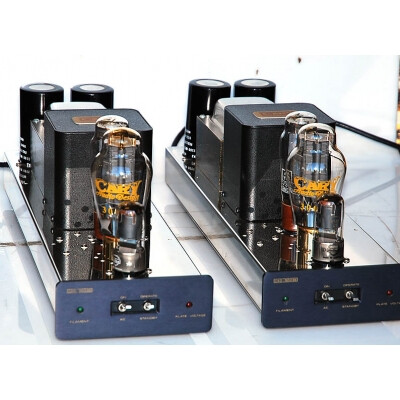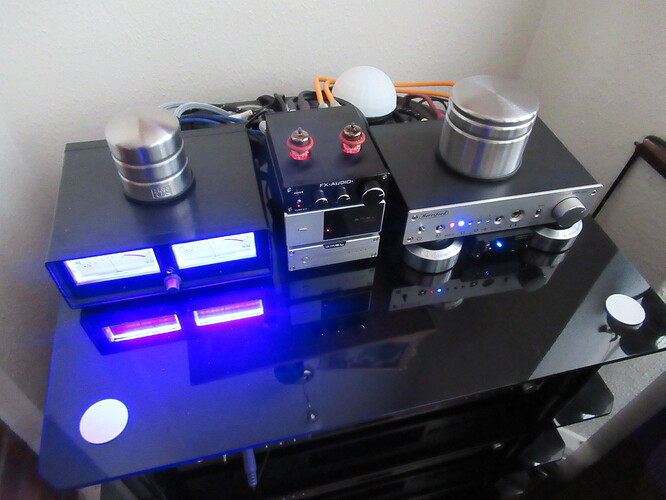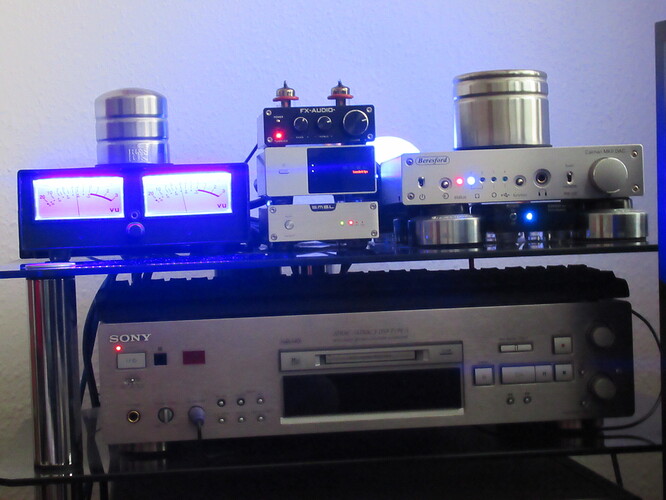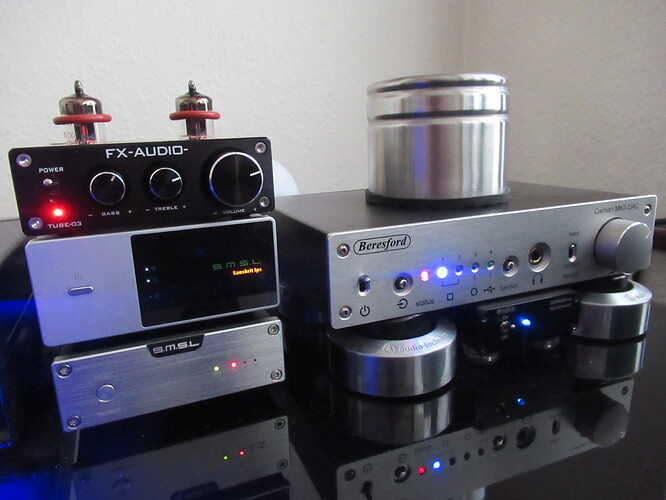Yes so is mine. He was 17 1/2 and my best buddy (don’t tell her indoors). My condolences to you.
Simply put, tubes vs. digital are going to be taste. Some points about tubes
-
tubes inherently cannot produce non-harmonic tones. Unlike digital circuits where non-harmonic tones may be reproduced and sent a speaker (which is damaging to the speaker). This is an unfortunate artifact of digital amplifiers. Some newer amps are hybrid, giving what some may feel are the best of both worlds (see 3rd bullet). This is probably (outside of any sort of sound coloration) the most significant difference/advantage of tube amps. That’s not to say that some non-tube amp manufacturers haven’t created some very good signal processing to avoid or prevent such to try to achieve what is inherent to a tube.
-
the lifespan of a tube varies - mostly by the number of hours powered on. Most modern digital equipment, manufacturers tends to prefer that they are left on (or in standby but not actually powered “off”). Tubes on the other hand should be powered on and allowed sufficient warm-up time (most modern tube amps actually have a safeguard that ensures sufficient warm-up time before they will produce audio). Given very frequent use (daily/almost daily) and duration of time per session of a tube amp - it wouldn’t be unreasonable to replace the tubes in the amp every 12-18 months.
-
tube vs. digital, preference will be what your ears prefer based on the combination of amp + cable + speaker - there is no “silver bullet”.
-
regardless of what you hear, never (ever) run tubes “hot”. The biasing of a tube should be to manufacturer’s spec (for each tube). If you run them ‘hot’ you risk damaging not only the amplifier but the associated speaker(s). Running them ‘hot’ (bias-wise) can also reduce the lifespan of the tube. Bias will be generally be something around 2V, but again - may vary based on manufacturer.
-
when you purchase tubes, get matched sets (depending on the quality of the amp, tubes, etc - this can make a significant difference). Personally prefer to replace all tubes in a given monoblock, even if some are being replaced “early”. never get skin oils on the tube, install them, allow them to warm and play music (low volume) for about 30 minutes. Then adjust the bias and again somewhere between 50-100 hours later. Even with daily use, the bias shouldn’t need to be checked/adjusted more than once every 4-6 months.
-
tubes are going to be power hungry (compared to their digital counterpart). Digital amps can be significantly smaller for far greater output compared to tubes.
-
as far as a tube “going bad”, short of some interesting test equipment - when you notice that the sound isn’t as good as you recall… New tubes will take some time to settle and then their sound will usually significantly improve. That sound will remain for quite some time and then eventually they will subtly decay. The decay in sound quality usually doesn’t become terribly noticeable until the tube is quite degraded as the decay (of the tube itself) is so subtle that you may not notice. Periodically playing a track “that know extremely well” should help in determination. Certain sounds may become thin, sound stage, etc.
-
if you start mixing and matching components, you may find an unexpected combination that is preferable. Such as tube pre-amp with solid-state amp or vice-versa. There’s nothing that says the combination has to be anything, except what you find to be most pleasing for a given listening session.
Neither is “better”, per se. Let your ears make the determination. No matter what direction you go - you can be happily assured that regardless of path, it will find a way to consume an ever increasing volume of those green rectangles…
Or pink or red or purple or blue etc depending on geography.
In addition to Floyd Toole’s comment on the amplifier’s grip on the loudspeaker, the other interest in tubes has traditionally been the “warmth” from harmonic distortion of tubes. If you’d like to hear a few forms of that without breaking the bank, IFi Audio have a product called micro iTube that allows you to switch in class A and Class A/B tube distortion to flavor your system. I experimented with it for my pro gear, where tube distortion is highly desirable for guitar and harmonica amps. I have about 20 tube preamps, pedals and amps for making music. All my reproduction of music is solid state, although I have enjoyed the sound of some modern tube circuits at audio shows.
I use a buffer with valves, between my Beresford Caiman II DAC and my amp (NAD C352). It is Chinese but I have Mullard valves in place. It also gives bass and treble control if needed. It is very engaging and adds ‘something’, possibly ‘presence’ that is enjoyable. These devices are quite variable in quality and durability… so changed often … but they are comparitively cheap so worth the tinker value! If it sounds agreeable to your ears…either with or without valves…so be it!
No need to overthink it, like many things on the internet it is opinion masquerading as fact. I run a mix of tube and solid gear mostly of my own design. (All the power amplifiers are tubed, as are line stage, and phono stages, crossovers and other sources are all solid state.) It all works nicely for me. Depends entirely on what you think sounds good, how much effort you are willing to put into matching components that work well together, your budget and how much maintenance you can and/or are willing to do. It’s a choice without too many downsides other than like most other things audio you will have to spend money… 
Wow, there’s a lot of blow-hard in this string of replies, I couldn’t read them all. Clearly your question stirred emotions (or just BS). Let me add mine…
I have lived both sides of your question. In the mid-nineties I spent some time in Japan and in my off-hours enjoyed touring Akihabara, the hub of Japanese electronica of all kinds. There was (still is?) a mania for valve amplification in Japan and I joined in albeit with American CARY dual mono CAD 300B amps.

I kept them for about ten years and they were truly delightful. I made a friend of a local audiophile shop owner who enlightened me about what to listen for and how to take care of the tubes…in particular the 300B tubes which do the heavy lifting. Such tubes have about 60,000 hours of life and a replacement set (readily available but over AU$1000/pair) will take a hundred hours to bed in.
The sound is “sweet”, euphonic, etc., which my friend described as being due to the natural distortion characteristics of tube amp circuit being even harmonic as opposed to solid-state, transistor circuit which have odd harmonic distortion modes as well. This may have been so much BS, but the ascribed characteristics did match with what types of sound were best with the CARYs - great for voices, acoustic guitars, not so for grunge and high dynamic music, perhaps.
One issue with 300B single-end amplification is low power output - mine had only 9 watts per channel into moderately efficient speakers (about 88 dB/watt or some such) yet could easily wake the neighbours if needed. My music preferences suited this style of amplification (not much into rock n roll nor heavy duty orchestral) up until I wanted to turn my music room into a home theatre (5.1 channel) which caused me to trade the CARYs for a new multi-channel amp.
The search took a long time because the solid state amps I auditioned had a certain harshness…or was it a lack of sweetness? Eventually I found the ARCAM class-G amps and they were just as enjoyable with straight music (2-channel) amplification albeit slightly different in sound. 10 years on I still have the ARCAM kit.
AND, through most of this saga I have the same speakers - ALMARRO M2A (based on Focal drivers)- made by a passionate Japanese valve amp builder who wanted speakers suited to his hardware. Unfortunately the chap died some years ago and there are no more such speakers.
I guess there is another story here, the speakers were built to suit the single-end valve amps, yet proved marvellous with good quality modern solid state amplification.
End sermon.
What were the results from your experiments? Useful or not?
I totally concur. I would just add my 2 cents worth though. I converse is true as well - speakers that were designed with valve amplifier “compatibility” not being high on their list of priorities may work fantastically well with Valve amplifiers.
Anthony, I mention it because it did deliver the sound of tubes. It was not as useful in my pro pedal board as some others. It’s useful learning to add those tones to a very clean set up to help understand which distortions you like and at what levels. I recall that Nelson Pass developed a circuit so you could control the harmonics from his tube amps, and people preferred a certain level of distortion. I did not add the iTube to my home set up, because I prefer not to try to change the intention of the sound engineer and producer when listening to other people’s music. And for my own home studio, I want to know what I’m getting from the recording process.
Let’s just put this here and see what happens. 
https://www.kenrockwell.com/audio/why-tubes-sound-better.htm
I have no problem with tubes at all. I am however struck by the high number of tube fans. In many other threads the big concern is minimizing distortion, but here we are discussing the benefits of distortion. To get back to the OP, I’d say with well designed amps the question is a choice to distort or not (tube vs SS), rather than which distortion is better.
It seems some prefer tubes because it creates a 3D quality, which from what I understand has been shown to be more important to the listening experience than frequency response accuracy.
I’d like to take a moment to thank you all for your feedback and civility. I’m enjoying the history and stories this question has solicited.
An explanation about what makes loudspeakers ‘tube friendly’, FWIW -
If the objective of audio amplification is to minimize noise and distortion, properly designed tube and solid state gear will converge on sounding the same. If you want old or sloppy designs so you can choose your flavor of distortion then it’s a different question. I ran a tube preamp for years and decided one day to build a surround setup and sold it. Then I decided I wanted a separate two channel system and bought a Schiit Saga tube hybrid preamp to go along with my Schiit multibit DAC. Then one day I decided I was done with design for cuteness ( The Saga is a push/pull buffer with the tube on one side and a transistor on the other. No reason to do this except audiophiles like to look at tubes and to prove you can.). And replaced them both with solid state gear. If I get the urge to “upgrade” it will be to a Benchmark DAC and amp, truly state of the art performance at a price worth paying.
there’s a lot of bitterness and inverted snobbery in that post.
I think one of the biggest issues in “audiophilia” is that people talk about what “sounds better” to them in a very subjective way. A bit like adding brown sugar/white sugar or milk/cream/half and half to coffee.
Where it comes to coffee (and audio), I’m a purist - lightly roasted micro-lot beans, freshly ground prior to extraction (espresso or filter) with carefully controlled extraction rate/time to give the best and most consistent brew with no sugar or milk (best SINAD, linearity, nothing added, nothing taken away)
I take my beans out of a Tnuctip stasis field to roast just before they’re ground, so there!
Vincent, I think you’re being harsh and somewhat disingenuous here. Unless I’m mistaken, I didn’t see any reference to a $200 preamp.
Yes, you have some high end gear, but high end doesn’t mean it objectively performs better than affordable sota measuring gear at a fraction of the price.
Schiit Saga tube hybrid preamp - $200 ish when new, clearly the standard by which all tube gear should be judged.


